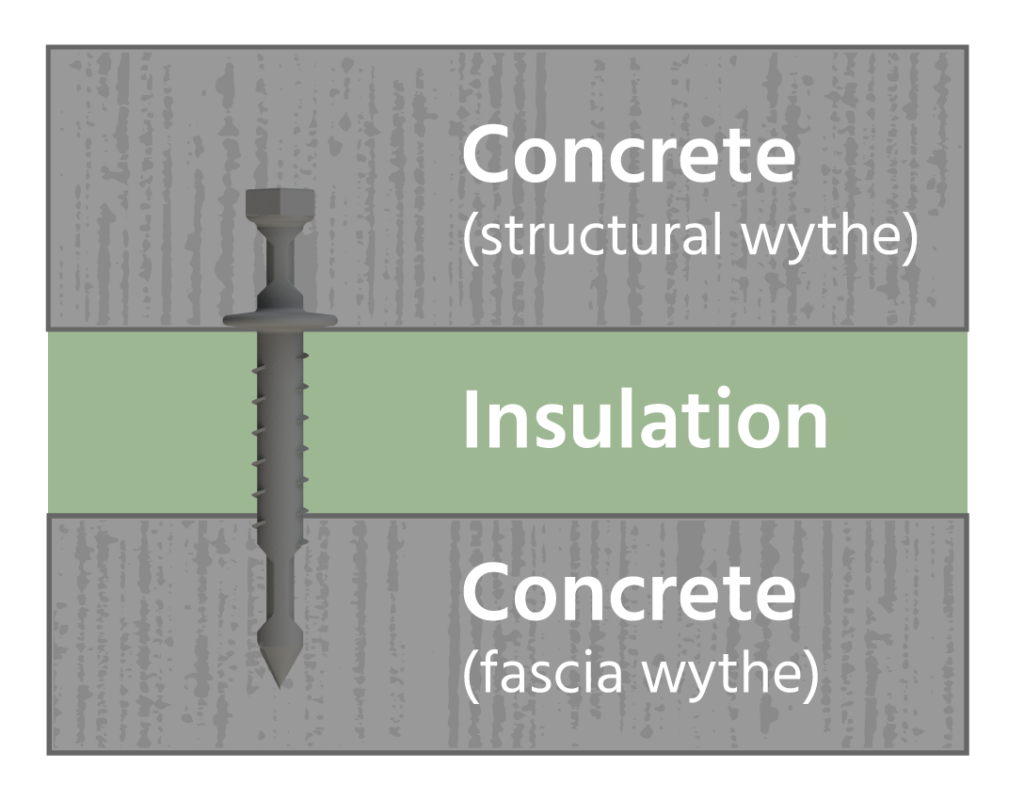Traditional insulated sandwich panels, comprised of a thin fascia wythe, insulation and a much thicker structural wythe would typically fall into this system. This system is comprised of our HK Standard non-conductive wall tie and any type of desired rigid insulation.
This system is designed to create a non-composite insulated concrete sandwich panel. This allows the two wythes of concrete to be tied together with a non-conductive wall tie but still allow the two layers to shrink or expand independently of one another using the tie for deflection.
- Holds a face wythe of concrete affixed to the panel without the need for thermally inefficient metal connectors or solid concrete sections
- High strength and low thermal conductivity
- High-performance, alkaline resistant, engineered thermoplastic
- In-place temperature range: -40°F to 200°F
HK Standard / Non-Composite Ties

All Standard Ties can be customized depending on project design and specifications. If you need a product not listed above, contact our talented engineers so we can meet your needs.
When to Use a Double Prong Connector Tie
One of the loads to which concrete sandwich-panel connector ties are subjected is forced displacement resulting from differential thermal growth or shrinkage of the two concrete wythes. As the insulation thickness decreases, the moment on the tie, resulting from this thermally induced forced displacement, increases exponentially, resulting in higher connector bending stresses.
In order to reduce connector bending stresses, a connector with a smaller diameter can be used. While this solves the bending stress problem, the tensile strength of the connector is reduced because of the resulting reduction in cross-sectional area. So, to maintain tensile strength while also reducing the bending stress, additional connectors can be used, hence the double-prong connector.
The combined cross-sectional area of the two prongs is slightly greater than the single-prong connector, thus maintaining the tensile strength while, because of the reduced diameter of each prong, also reducing the connector bending stress. The installation labor is not increased by needing to install twice as many connectors to achieve the same strength.
This thermally induced connector bending-stress issue is only a concern for tall wall panels, with grout under the fascia wythe, on extremely hot or cold days.
Our engineering team will help you determine which connector tie is most appropriate for each project.
Installation Instructions
You can find all the necessary installation instructions by HK product type on our Installation Instructions resource page.
Testing Standards
The HK Standard ties are tested in accordance with the ICC-ES AC 320. The table below displays the testing comparisons of some of our popular Standard ties.
You can view more complete testing reviews for each tie on their individual product pages.
| ST50 | ST75 | ST100 | |
|---|---|---|---|
| Tie Length: | 5.31 in / 135 mm | 6.25 in / 160 mm | 7.25 in / 184 mm |
| Embedment Depth (head): | 1.5 in / 38 mm | 1.5 in / 38 mm | 1.5 in / 38 mm |
| Embedment Depth (tip): | 1.81 in / 46 mm | 1.73 in / 44 mm | 1.73 in / 44 mm |
| Diameter Through Foam: | 0.5 in / 12.5 mm | 0.57 in / 14.5 mm | 0.57 in / 14.5 mm |
| Insulation Thickness: | 2 in / 50.8 mm | 3 in / 75 mm | 4 in / 100 mm |
| Structural Wythe Thickness: | minimum 2 in / minimum 50 mm | minimum 2 in / minimum 50 mm | minimum 2 in / minimum 50 mm |
| Fascia Wythe Thickness: | 2–4 in / 50–100 mm | 2–4 in / 50–100 mm | 2–4 in / 50–100 mm |
| Ultimate Tensile/Pullout ¹: | 1,260 lb / 5.6 kN | 1,660 lb / 7.38 kN | 1,660 lb / 7.38 kN |
| Shear Strength: | 1,300 lb / 5.78 kN | 1,700 lb / 7.56 kN | 1,700 lb / 7.56 kN |
| Ultimate Panel Shear Capacity/Tie: | 648 lb / 2.88 kN | 924 lb / 4.11 kN | 780 lb / 3.47 kN |
| Alkaline Resistance: | Excellent ² | Excellent ² | Excellent ² |
| Impact Resistance: | Excellent ³ | Excellent ³ | Excellent ³ |
| Fire Performance: | Resist 300-lb tension load for over 90 minutes when fire tested per Section 7.4.3 of ASTM E1512-01 | Resist 300-lb tension load for over 90 minutes when fire tested per Section 7.4.3 of ASTM E1512-01 | Resist 300-lb tension load for over 90 minutes when fire tested per Section 7.4.3 of ASTM E1512-01 |
| Thermal Conductivity: | 2.1 Btu-in/hr-ft2 °F 0.30 W/m°K | 2.1 Btu-in/hr-ft2 °F 0.30 W/m°K | 2.1 Btu-in/hr-ft2 °F 0.30 W/m°K |
¹ Concrete f’c = 3,000 psi
² 99.1% retained strength after 3,000 hours of conditioning in pH12 solution, Testing of HK Composite Low Conductivity Ties to ICC-ES AC320 Criteria, Report Number: ESP014387P.1, March 5, 2014, Element Materials Technology, 662 Cromwell Avenue, St. Paul, MN 55114-1720 USA
³ The un-notched Izod Impact testing: 21 ft-lb/in (1100 J/m)
U.S. Patents D804,288 S 10,000,928 B2 5,519,973 5,830,399 5,987,834 5,809,723 6,112,491 | Canadian Patent 2,187,284 | Australian Patent 687,367 | European Patent 0745265 | Mexican Patent 201,274 | Chinese Patent ZL 95192498.2 | Japanese Patent 3,604,14
Made in the USA
Contact Us
Toll Free:
(800) 430-6316
International: +1 801-763-0907
Frequently Asked Questions
How do HK Ties work?
View the "How it Works" page to see a demonstration video.
Are HK Ties Tested?
Yes. Our patented low-conductivity polymer systems excel in tests for tensile strength, shearing, concrete pull-out, long term alkaline resistance, fire, cyclic fatigue, and many building code certifications. See HK testing reports here.
Do I save money using HK Ties?
Yes. Our simple manufacturing process used to make HK Ties, called thermoforming, reduces our output costs which increases your “bang for your buck”. Not only that, HK Ties reduce the R-value of the wall by less than 1% compared to as much as 75% reduction with steel and/or typical solid concrete section ties. This results in maximum energy savings!
Also, because HK Ties are manufactured using a simple process, they cost less to produce and we can pass along that savings to our users.
Does HK use fiberglass to make Ties?
Being the best means being different; we don’t use fiberglass in our HK Standard Ties. HK Standard Ties are made from an engineered reinforced thermoplastic, enabling our standard ties to be more durable than competitor ties. In contrast, HK Vertical Pour/ Modular Precast Ties and Composite Action Ties are made from a fiberglass reinforced thermoplastic.
Regardless of the engineered make-up, all HK Ties are designed to resist impact and shock loads during precast panel transportation and erection. The resin retains its strength at high temperature and provides maximum long-term chemical resistance.
Construction jobs come in many different shapes and sizes. Different jobs require different ties. Our HK Tie experts are here to help you find the best tie for your project. Contact us today!
Is plastic as strong as fiberglass?
Fiberglass is plastic—reinforced with glass fiber. Strength-wise, it is true that some types of fiberglass have a higher material tensile strength than HK Tie resins. However, high material tensile strength is only one factor responsible for the tensile capacity of a tie. The minimum cross-sectional area and manufacturing processes together with inherent material properties ultimately determine tie strength. The actual delivered tensile and shear strengths of HK Ties are many times higher than required.
The plastic used for the HK Standard Ties is a high-impact, high-temperature, chemical resistant engineered thermoplastic. The plastic used for the HK VP (Vertical Pour) and Modular Precast Ties is glass fiber reinforced.
Every job is another dragon to slay. We will help you get the job done cost-effectively, safely and as quickly as possible. Contact us today!
Can my project receive LEED points for using the HK Building system?
Yes. With the HK building system, you can go green and save green. HK Green Building Insulation Systems are designed to meet green building standards for better thermal protection and energy performance from longer-lasting, environmentally benign building materials.
The system is created using extruded polystyrene foam (XPS) insulation in-between two concrete wythes. Highly durable HK Ties, inserted into the XPS, have been proven to reduce the insulation R-value by less than 1% Compare that to as much as 75% reduction with steel and/or typical solid concrete sections! This small change can make a big difference! Start saving and contact us today.
Does HK offer a turnkey solution?
Yes. Our turnkey foam fabrication solution is one of many reasons why we are the concrete sandwich construction industry leader. We specialize in and have extensive experience with foam fabrication processes.
When the foam is fabricated, boards are pre-cut to fit architectural drawings. We make it easy for you as we provide specific foam layout drawings and pre-drill the XPS energy-efficient insulation board to accommodate HK Tie insertion. HK insulation foam boards come to the job site, placement ready. Bye, bye head scratching and complicated puzzles, hello revenue.

